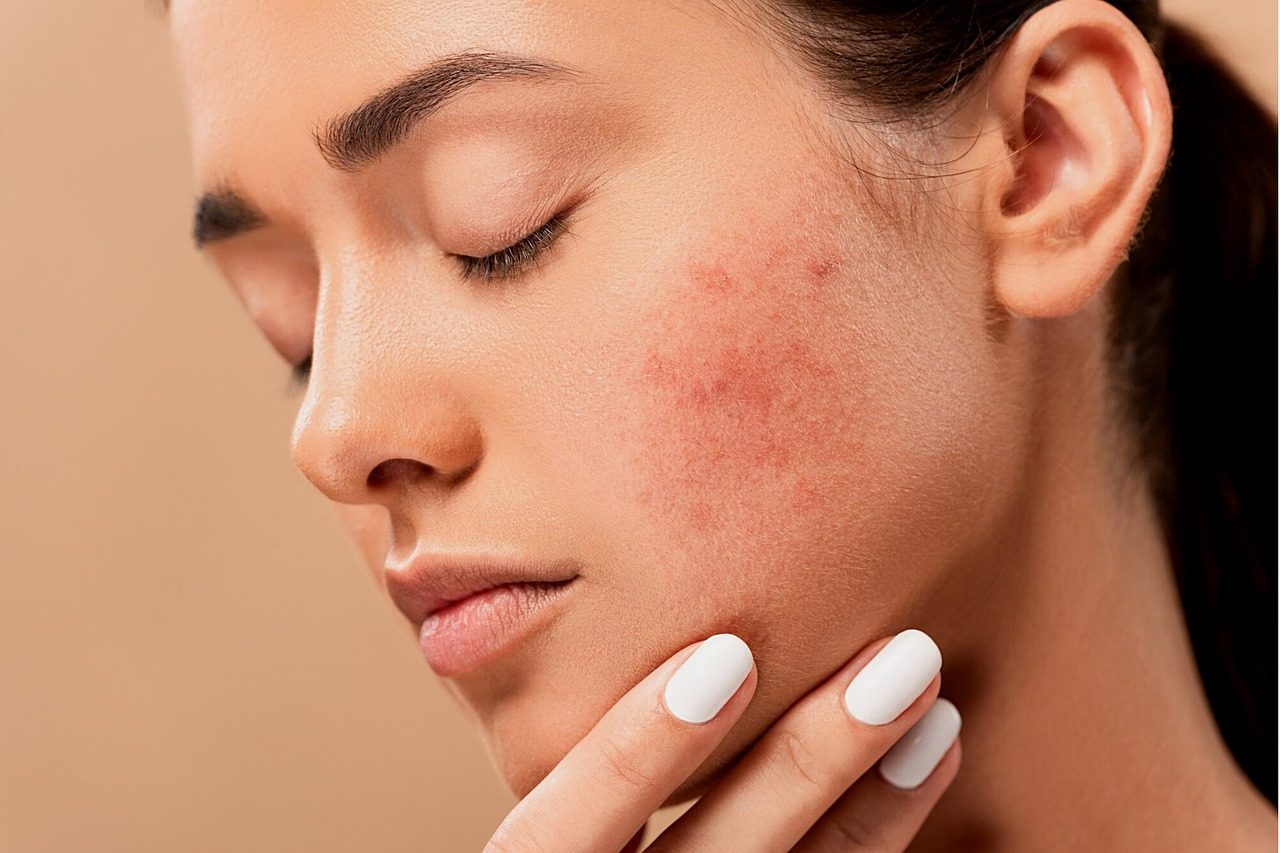
Ah acne, as if the clogged pores and pimples weren’t enough… Spotty skin can be a pain but sometimes, the scarring it often leaves behind can be even more tricky to treat, which varies not only based on the type of scars that surface but also the type of acne that contributes to the scarring. Whether your scars are shallow or deep, we’re here to help you understand and differentiate between the types of acne scars that exist and the ways they can be healed from topical ingredients to professional-level treatments. Sound good? Then let’s get to it!
What Causes Acne Scarring?
There are multiple factors that contribute to acne scarring. Two of the most common reasons these scars occur is due to cystic acne (the most severe form of inflammatory acne) and pimple picking. For those who don’t know, cysts form deep within the skin, are the largest in size, contain pus, and often resemble boils. Because of this, they require more pressure than the average pimple to break, so scarring and infection are likely to occur. The latter happens when the skin of the infected pore bursts, causing the debris and bacteria present in inflammatory acne to spread, damaging healthy skin cells. But the reason scars form doesn’t end there.
Even fussing with other types of inflammatory acne (pustules, papules, and nodules) and non-inflammatory acne (whiteheads and blackheads) can cause scarring and so can the skin healing process that occurs when the body produces new collagen fibers (aka connective tissue) to repair what’s been damaged. And although it’s a process that’s restoring the skin, it can contribute to scarring. Unfair, we know. So, what types of acne scars can develop?
The Types of Acne Scars
Boxcar Scars
Boxcar scars are deep, defined depressions in the skin that have a box-like shape, hence the name.
Icepick Scars
Icepick scars are narrow impressions in the skin and resemble ice pick punctures or tiny holes.
Rolling Scars
Okay, not that type of roll.
Rolling scars aren’t as defined and sharp-looking as boxcar and icepick scars but are still deep within the skin.
Hypertrophic Scars
Hypertrophic scars aren’t as deep within the skin as other types of scarring. Instead, they’re raised and closer to the surface.
How to Prevent Acne Scarring
Many assume that the best way to prevent acne scarring is to refrain from picking at breakouts and while this is true, acne formation is what you want to undoubtedly avoid. But we know this isn’t always possible, especially if you have acne-prone skin. With that said, the best way to keep acne at bay is by incorporating effective acne-fighting ingredients into your skincare routine that focus on minimizing oil production and inflammation (as redness is often associated with breakouts). And if you’re looking for some pore-perfecting and pimple-preventing products that’ll give you the best bang for your buck, you can check out our blemish-banishing bundle (formally known as The Clear Set).
How to Treat Acne Scars
If you can’t seem to escape the realm of acne scars, these are some of the best topical ingredients and professional-level treatments to minimize the severity of them and help clear your complexion.
Topical Ingredients
Vitamin C
From reducing inflammation to improving hyperpigmentation, there’s an abundance of vitamin C benefits that’ll help tackle those pesky scars.
One of the most notable features of vitamin C is its ability to promote collagen production, which enhances wound healing, making it the perfect treatment pal for scars. And its antioxidant properties work to increase cell turnover, helping to kickstart the skin’s regenerative process! It’s also important to keep in mind that the concentration of vitamin C needed to help treat acne scars will depend on the severity of them.
Retinol
Another great product to help treat acne scars is retinol. Like vitamin C, retinol boosts collagen production and increases skin cell turnover rate. It also works to improve tone and texture and treats not only the surface layer of skin (the epidermis) but also the dermis (the second deepest layer of skin) over prolonged use. And remember, if severe acne is the concern, an over-the-counter retinol isn’t going to be effective. In cases like these, prescription retinoids are needed and will be recommended either by a doctor or dermatologist. Also keep in the mind that a very low concentration of retinol should be used initially and can be increased over time once your skin has built up a tolerance to it.
Lactic Acid and/or Glycolic Acid
These two AHAs have an abundance of benefits but they both share the same primary goal: exfoliation.
When these AHAs are applied, they work to loosen the bonds between cells, sloughing away at dead, dry, and damaged skin to pave the way for new, healthy skin cells to form. And both AHAs are effective at minimizing sebum production, lessening the chance of breakouts from forming. And less breakouts equals less scarring! In terms of differences, lactic acid contains larger molecules and can’t penetrate as deeply into the skin (meaning that your skin will get more of a surface-level treatment when it’s applied), while glycolic acid can in fact penetrate further.
Professional-Level Treatments
Microneedling
Microneedling is a minimally invasive and risk-free procedure that can help improve the appearance and texture of acne scarring. The process involves running a hand-held device comprised of needles across the skin in slow and gentle horizontal, vertical, and diagonal movements, creating microscopic wounds on the surface. These newly created wounds then signal to your skin that extra collagen and elastin is needed to help rebuild and repair what has been “injured.” The result? Firmer, even-toned skin with improved texture and less noticeable scarring! Intrigued? Click here to learn more!
Chemical Peels
Chemical peels range from light to medium to deep and involve the application of a chemical solution to the surface of skin to remove the top layers of skin (which sounds terrifying, but it isn’t). The result? Skin that grows back smoother and more even toned. Do keep in mind that depending on the type of peel you choose; multiple treatments may be needed. You can learn more about this procedure and the best at-home chemical peels on the skincare market here.
Microdermabrasion
Microdermabrasion is another popular acne treatment that’ll leave your skin feeling…
Like chemical peels, microdermabrasion involves the removal of surface-level skin. It uses fine crystals or diamond-stubbed tips to scrape the skin, suctioning out any dirt and debris. It’s basically like vacuuming your skin! It’s also a treatment that’s less invasive than chemical peels and is more cost-efficient. To learn if microdermabrasion is the best treatment option for your skin’s scarring needs, you can check out more information here!
The Bottom Line
Just like acne happens, acne scars happen. And it’s normal for them to appear, particularly for those who experience inflammatory acne. The important thing to remember is that acne and scars do not define you. With that said, we hope you enjoyed learning why scarring occurs and how you can tackle the after-effects of breakouts. Follow us on socials and let us know what your favorite remedies are for treating scars and what MOZ products have helped lighten and fade them. Chat soon!

